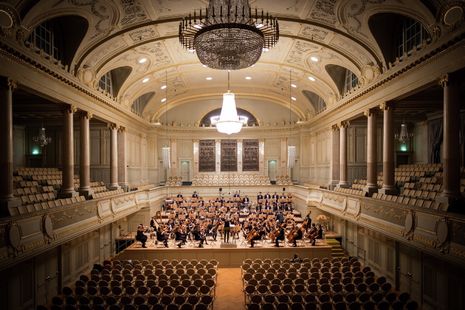The plight of the female brass player
Scarlet Rowe reflects on her experience in the male-dominated space of the orchestral brass section.

Being the only female in an all-male group can be intimidating; I’m sure it would be similar if the situation was reversed. Though, in some ways, this is to be expected considering that one’s perceived differences are bound to be amplified in such a situation.
Homophily, the concept that you are attracted to people like yourself, is as much at play in orchestras as it is in life more broadly. Growing up playing the trumpet, I tended to play the bottom parts because I didn’t have the confidence to ask for more. I thought myself incapable of playing higher parts, despite being just as qualified as everyone else. I can’t help but wonder if this would have been the same if the sections had had a more even gender balance. Either way, it would have been nice to know how much gender played into these worries, versus my own nervous disposition.
“Growing up playing the trumpet, I tended to play the bottom parts because I didn’t have the confidence to ask for more.”
In my teenage years, I became used to the toxic competitions that characterise brass sections. Up until university, the pretentious warm ups of who-can-play-the-highest-notes or who-can-remember-the-Hayden-concerto-off-by-heart had very much become a given. Kudos wasn’t secured by being kind and understanding; instead, it was achieved by being loud, and if I’m honest, a tad arrogant. As you can imagine, trumpet sections were not the friendliest of places.
It isn’t unreasonable to say that orchestras lack sufficient diversity. They reflect society’s inequalities, and often amplify them. Last year, Quartz at Work found that of the world’s top 20 orchestras, 69% of the full-time musicians were men. Just one of the 122 trumpet players, 99 trombone players and 26 tuba players identified as female. Relatively speaking then, the trumpet section (holding the sole female brass musician) is doing well. One year on, I doubt that much – if anything, has changed.
There are many reasons why fewer women play brass, and for why we know less about those who do. Women may think they won’t fit in (because, demographically speaking, they don’t), and feel intimidated by the majority-male demographic. They may not even consider brass instruments as an option in the first place, thinking it unsuitable for their constitution. Even when women fight the odds and become highly-qualified brass players, their struggle does not end. They then face the challenge of getting into top orchestras, where the odds are very much against them.
Blind-auditions help, but they don’t solve the issue as the rounds progress and stereotypes kick in. This is because auditions stop being blind as the applicant pool is whittled down. And, on the very rare occasion when women do get into top orchestras as brass players, they face the challenge of being in a minority and fighting the prejudices that accompany this. Despite changes in recent years, brass instruments are still seen as inherently ‘masculine’: bold, loud, and powerful. Though the category of masculinity is being challenged today, and rightly so, brass instruments are still associated with its traditional features. As a result, for many people it seems natural that boys are well-suited to play brass.
“There are many reasons why fewer women play brass, and for why we know less about those who do.”
Whilst writing, I have tasked myself with naming at least three famous female brass players. I can’t even name one. I find myself questioning whether this is a reflection on me or mass culture? I would suggest the latter.
In the 19th century, women were discouraged from playing brass and woodwind in case it distorted their facial features. I’ve often felt self-conscious whilst playing, refusing to play in front of other people in case I look ridiculous. Whilst this problem may not be inherently gendered, the constant judging of females by their appearance doesn’t help. Playing brass requires one to distort their facial features and achieve previously unseen states of redness. This is not seen as very becoming and attractive; as such, it challenges the framework of femininity. The military and jingoistic connotations of brass instruments don’t particularly help either…
In 1981 Philip Griswold studied the sex-stereotyping of instruments. He asked a group of people to rate orchestral instruments out of 10, with 0 being ‘most feminine’ and 10 being ‘most masculine’. The trumpet averaged at a 7.72/10, whilst the trombone and tuba scored even higher on this count. Forty years on, gendered stereotypes continue to prevail. Despite the efforts of many, brass and masculinity appear to be as close-knit as ever. A male flautist may be mocked for being effeminate (which, by the way, appears to be an insult), whilst a female brass player may feel completely out of her depth in an all-male section. Gender doesn’t need to be a defining feature of anyone, but it often becomes one in the eye of the beholder.
It is difficult to change entrenched attitudes, especially because sometimes we do not even recognise the stereotypes we harbour. On the bright side, as more women enter brass circles, common conceptions of brass will alter – even if the process is slow and onerous. I do not have a working solution to the plight of the female brass player, as there is no quick-fix remedy. There are things that we can do though. We can actively encourage girls to play brass instruments in schools for one. We can look up and talk about female brass players more often too, and help to raise their publicity. We can give deserving female brass players top positions, continuing blind auditions to the final round. I simply refuse to believe that only one female is capable of playing a brass instrument in the world’s 20 highest rated orchestras.
Whilst class, race, and gender issues most certainly remain, orchestras are beginning to reflect society’s make-up a little more. Although attitudes don’t change overnight, they always have the potential to do so. It would be wonderful if we could capitalise on this rising potential for change, and turn it into something concrete.
 News / SU reluctantly registers controversial women’s soc18 December 2025
News / SU reluctantly registers controversial women’s soc18 December 2025 Features / Should I stay or should I go? Cambridge students and alumni reflect on how their memories stay with them15 December 2025
Features / Should I stay or should I go? Cambridge students and alumni reflect on how their memories stay with them15 December 2025 News / Dons warn PM about Vet School closure16 December 2025
News / Dons warn PM about Vet School closure16 December 2025 News / Cambridge study finds students learn better with notes than AI13 December 2025
News / Cambridge study finds students learn better with notes than AI13 December 2025 News / Uni registers controversial new women’s society28 November 2025
News / Uni registers controversial new women’s society28 November 2025










